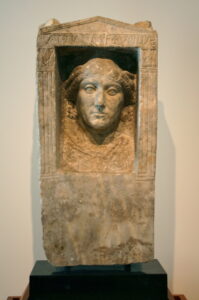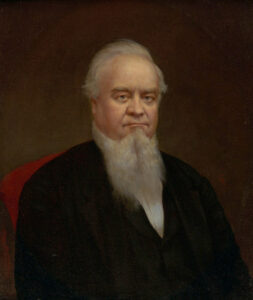Today’s post comes from Taylor Shoolery, Art Center docent and Vassar College class of 2012.

Last week at the Kaleidoscope presentation, a series of interdisciplinary panels that address a work of art, four Vassar professors came together to discuss Mark Rothko’s painting, No. 1. Peter Charlap of the Art Department, Kate Susman of the Biology Department, Carolyn Palmer of the Psychology Department, and Patricia Wallace of English Department all presented on the Rothko work through the unique lenses of their own academic specialties.
Professor Charlap started off the evening with a discussion of Milton Avery’s influence on Rothko. He toured the audience through images of works early in Rothko’s development to give us a sense of where this painting fits into the trajectory of Rothko’s career. As it turns out, No. 1 came at a pivotal point in the development of Rothko’s style, as he was right on the verge of producing his mature, and most recognizable, images.
Professor Susman, coming from a background in the hard sciences, had a very different set of questions when she approached the work. Considering how evolution has affected human vision, she questioned what kinds of effects Rothko’s color choices have on the viewers of the painting. Red, one of the dominating colors of the painting, has evolutionarily served to grab attention. However, human beings are among few animals that have tri-chromatic vision, which means we have receptors in our eyes for green, red, and blue. From these three kinds of receptors, humans can see around 10,000 shades of color. While many animals have monochromatic vision—like nocturnal animals, which see in shades of grey—and still others have dichromatic vision—like dogs, which see in shades of blue-green—the most evolutionarily recent addition to tri-chromatic vision is receptors for red light. Susman shared with us that red light was a useful addition to our vision because it helped our ancestors see red berries and the red hue of the female posterior when she was fertile. As such, Susman suggested that when we see the color red, we are biologically conditioned to think of food and sex. While Rothko probably did not have this in mind as he painted No. 1, it can help us make sense of our reaction to the work.
Next, Professor Palmer brought her expertise in psychology to the table. Having specialized in human movement, Palmer discussed how our eyes move across a painting. She shared several diagrams that tracked eye movements of subjects as they encountered a particular painting and were asked several questions. On average, she told us, our eyes move three times a second, so we cover a lot of ground very quickly. Furthermore, Palmer discussed how our body movements, our posture, and facial expressions affect how we feel about a given visual stimulus. For example, subjects were far more likely to remember a work of art if they were smiling when they saw it, even if it was a forced smile. In light of this new information, Palmer urged us to be aware of our bodily movements as we encountered the work and to notice how those around us held themselves. These minute details about our own bodies can have a great effect on our experience of the work itself.
Finally, Professor Wallace drew on her background with poetry and the arts to approach the work. She posed the question, “What and where is the painting?” She answered this question by claiming the painting exists in our experience of the painting, in the imprint it leaves on our memory. In this way, a painting is “both a real and a fictional image,” real in that it exists on the canvas, and fictional in the way it endures in us long after we have left the gallery. Next, Professor Wallace asked us each to take out the pencil and sheet of paper we had been given as we entered the space. She asked us to take a moment and just look at the reproduction of the image that was projected on the wall, to try and let everything from our day fade away and focus on the painting. After some time of simply looking, she asked us to jot down our reaction. This is an activity I would urge any of you who can make it into the gallery to try. What is most amazing to me is that I have now tried this activity several times, and each time I write something different. This is a testament to how fluid and ever-changing this work is, of how unstable even the most stable of things can be.
Finally, the audience was invited into the gallery to watch an excerpt from the play Red by John Logan, about Rothko in his studio. In front of the very work we had been discussing all evening, Rothko’s process seemed to come to life in the excerpt performed by Mike Masure and Charlie Nicholson, both of the class of 2012, and directed by Kelley Van Dilla, also class of 2012.
With so many different perspectives on the work, there was an entry point of exploration for everybody. While I have seen this Rothko at least once a week for the last three and a half years I have been working at the art center, it lit up in a new way at the Kaleidoscope event.





Professor Palmer’s commentary reminded me of another interesting fact about smiling: even when we force a smile, we stimulate the production of endorphins and serotonin. Expression is essentially the use of different facial muscles, some of which are completely involuntary while others can be controlled. It makes sense to me that posture and expression can influence how we perceive a work. In turn, color and composition stimulate reactions as humans and as individuals, as we associate visual imagery with our memories. Perhaps this can explain why some artwork seems to elicit a widespread response, while others ignite very contradictory and sometimes quite emotional reactions.